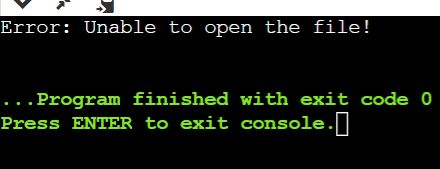ios::setstate() function in C++
In this article, you will learn about the ios::setstate() function in C++ with its example.
C++ Stream State:
Input/output streams in C++ preserve a state that represents the stream's status following different operations. A collection of flags, each designating a distinct condition, serves as the state's representation.
Among the often used flags are:
1. ios::eofbit:
- If the end-of-file is found during an input process, set the ios::eofbit.
2. ios::failbit:
- If a logical fault arises during an input/output process, the value of ios::failbit is set.
3. ios::badbit:
- Set in the event that an input/output operation encounters a read or write error.
4. ios::goodbit:
- It denotes the absence of mistakes.
These flags are kept in a bitmask-type component of the ios class named iostate.
The function ios::setstate():-
- One of the most important member functions of the ios class is ios::setstate(), which is used to directly set or modify a stream's state flags.
- The flags to be set are represented by the argument state in this case.
- A mix of ios::eofbit, ios::failbit, ios::badbit, or ios::goodbit may be used.
- With the use of this function, you can regulate and modify the stream's state in response to particular program conditions.
- By setting the flags supplied as inputs, the setstate() method of the C++ ios class modifies the stream's current state. As a result, this function modifies this stream's internal state.
Why is ios::setstate() used?
In C++, the ios::setstate() function is essential for controlling the input/output stream's state. Its main goal is to make it possible to modify the state flags connected to a stream explicitly. State flags are indications that provide details about the stream's state following different operations. ios::eofbit, ios::failbit, ios::badbit and ios::goodbit are among the flags.
Developers can purposefully set or change these flags depending on certain circumstances in their programs by utilizing ios::setstate(). This precise control over the stream's state is particularly beneficial when dealing with file I/O or network activities, especially in scenarios where error detection and recovery are critical. This functionality allows developers to manage the stream's state effectively, enabling them to implement appropriate error-handling mechanisms and ensure reliable operation when encountering potential issues during input/output or network operations.
Advantages of ios::setstate():-
There are several advantages of the ios::setstate() function. Some main advantages of the ios::setstate() function are as follows:
1. Accurate Error Handling:
- ios::setstate() facilitates accurate error handling by allowing developers to specify particular flags depending on the type of error encountered during stream operations.
- For instance, you can change the ios::eofbit to signal this situation directly if an attempt is made to read from a file that reaches the end-of-file.
2. Custom Error Reporting:
- Developers can utilize the ios::setstate() function to provide custom error reporting mechanisms.
- They can produce more enlightening error messages or take particular actions depending on the problems they discover by setting flags based on the details of an error.
3. Selective State Modification:
- The feature enables state flags to be modified in a selective manner.
- The developers can use bitwise operations (|, &) to change or unset individual flags or combine several flags to accurately control the state of the stream.
4. Better Recovery Strategies:
- Developers can use customized recovery procedures if an issue is identified using the stream's state flags.
- Depending on the precise error scenario, it could entail reopening and closing a file, asking for more user input, or executing other corrective actions.
5. Eliminating Red Flags for Additional Operations:
- It's customary to use clear() or a function to remove the flags set by ios::setstate() after resolving an error.
- It ensures that any further activities on the stream won't be hindered by persistent error situations.
Program:
Let's take an example to illustrate the use of the ios::setstate() function in C++.
Output:

Explanation:
1. Include Headers:
- The program contains the headers required for file stream operations (fstream) and input and output stream operations (iostream).
2. Main Function:
- It is the first thing that the program does.
3. Open a File:
- An ifstream (input file stream) is used to try and open a file called "example.txt" for input.
4. Check whether the file is open:
- It verifies whether the file is open. If not, a file is used to set the failbit. setstate(std::ios::failbit) to signal that the file could not be opened.
5. Verify Stream Condition Following Operation:
- Following the opening operation, it verifies the stream condition.
- The failbit indicates that there was a problem opening the file if it is set.
- After that, the software uses a file to clear the failbit and outputs an error message to the standard error stream (std::cerr).clear() to enable further stream operations.
6. File Opened Successfully:
- The file will read and show its contents if it was opened successfully, meaning there were no issues encountered during the opening process.
- In addition to reading each line from the file using std::getline() and displaying it on the console, it prints a success message to the standard output stream (std::cout) and employs a while loop.
7. Return from Main:
- The operating system receives 0 from the program, signifying that it was successfully executed.
|

 For Videos Join Our Youtube Channel: Join Now
For Videos Join Our Youtube Channel: Join Now










